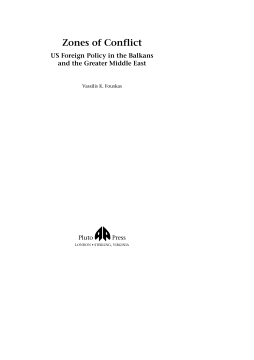
Additional Information
Book Details
Abstract
The US has major interests in the Balkans, the Greater Middle East and the Eurasian zone, which determine its political and military strategies in the region. What are these interests, and what strategies are used to ensure that they are maintained? Examining the balance of power between the US, the EU and key EU states, Vassilis Fouskas offers a critique of US foreign policy and its underlying motivations.
Fouskas argues that the major US objectives include control over gas and oil producing zones; safe transportation of energy to Western markets at stable prices; and the elimination, but not destruction, of America's Eurasian competitors. He asserts that US foreign policy is therefore driven by the desire to maintain a strategic partnership with key EU states, while preventing the emergence of an alternative coalition in Eurasia capable of challenging US supremacy.
How does the US manage its interests in Eurasia and what are the particular strategies the EU has elaborated so far to deal with America's supremacy? Has US foreign policy undergone a dramatic U-turn after the end of the Cold War or, for that matter, after September 11th? What are the roles of Germany, France, Britain and Turkey, and how do EU-Cyprus relations affect the balance of power? This book tackles these questions and argues that the emergence of a social democratic administration in Eurasia is a feasible alternative to American unilateralism.
'A vigourous and challenging contribution of one of the most important debates of our time'
The Political Quarterly Publishing Co
Table of Contents
| Section Title | Page | Action | Price |
|---|---|---|---|
| Contents | vii | ||
| 1. Introduction | 1 | ||
| The Realist Chessboard | 1 | ||
| The Structure of the Book | 5 | ||
| Globalisation and European Integration | 8 | ||
| 2. The New Geo- politics of Gas and Oil | 11 | ||
| The 1990s: Years of Pandemonium | 13 | ||
| Conflicting Interests: Oil and Gas Projects in Eurasia | 16 | ||
| End of the Cold War? | 27 | ||
| 3. Scarface Politics | 34 | ||
| NATO's New Strategic Concept | 37 | ||
| Problems of Variable Geometry | 39 | ||
| Political, Moral and Legal Conundrums: The Kosovo War | 44 | ||
| US Successes | 50 | ||
| Muslims, Christians and Foreign Policy | 54 | ||
| The Limits of NATO | 58 | ||
| 4. Near and Middle Eastern Dilemmas | 63 | ||
| The Northern Tier and the Greek Turkish Dimension | 64 | ||
| The Arab Israeli Conflict | 67 | ||
| Conflict over Cyprus | 71 | ||
| Towards Summer 1974 and After | 76 | ||
| 5. Turkish Questions for the West | 81 | ||
| A Democracy Guided by the Military and Used as Such | 83 | ||
| The US and the Turkish Pivot | 91 | ||
| Summing up the Realist Game | 95 | ||
| 6. Eurasian Gambles over Cyprus EU Prospects | 99 | ||
| EU Cyprus Relations and Germany s Primacy | 101 | ||
| US Qualified Support to Germany and Greece | 106 | ||
| Greek and Turkish Arguments | 109 | ||
| Military Diplomacy by the Turkish Pivot | 111 | ||
| 7. Conclusion | 116 | ||
| US Policy in Eurasia: An Assessment | 116 | ||
| A Trans- Eurasian Convention Underwritten by Eurasian Powers | 120 | ||
| Re- conquering America | 125 | ||
| Notes | 129 | ||
| Bibliography | 157 | ||
| Maps 1. Oil and gas pipelines | 16 | ||
| 2. The Enlarged European Union | 36 | ||
| Index | 169 | ||
| Abdullah,King of Jordan 70 | 70 | ||
| Abkhazia | 22 |
